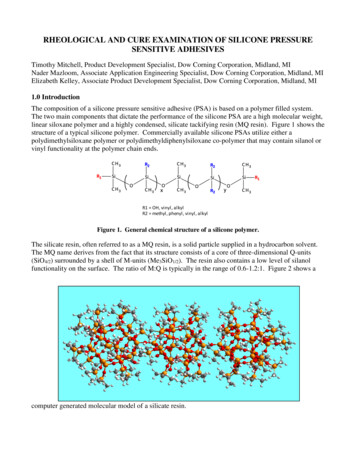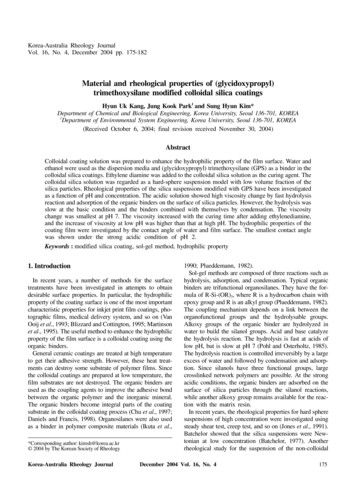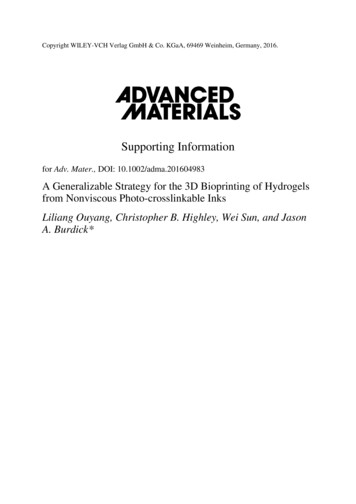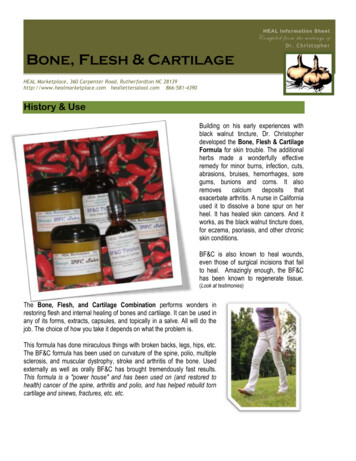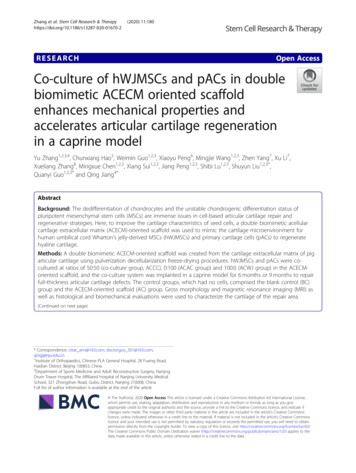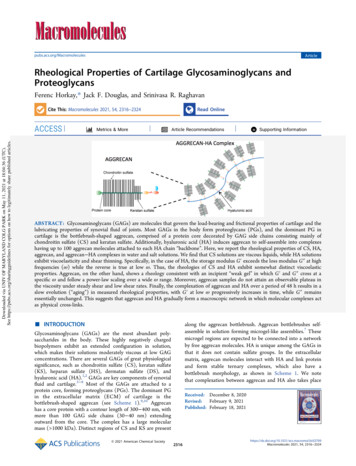
Transcription
pubs.acs.org/MacromoleculesArticleRheological Properties of Cartilage Glycosaminoglycans andProteoglycansFerenc Horkay,* Jack F. Douglas, and Srinivasa R. RaghavanCite This: Macromolecules 2021, 54, 2316 2324Downloaded via UNIV OF MARYLAND COLG PARK on May 11, 2021 at 18:04:36 (UTC).See https://pubs.acs.org/sharingguidelines for options on how to legitimately share published articles.ACCESSMetrics & MoreRead OnlineArticle Recommendationssı Supporting Information*ABSTRACT: Glycosaminoglycans (GAGs) are molecules that govern the load-bearing and frictional properties of cartilage and thelubricating properties of synovial fluid of joints. Most GAGs in the body form proteoglycans (PGs), and the dominant PG incartilage is the bottlebrush-shaped aggrecan, comprised of a protein core decorated by GAG side chains consisting mainly ofchondroitin sulfate (CS) and keratan sulfate. Additionally, hyaluronic acid (HA) induces aggrecan to self-assemble into complexeshaving up to 100 aggrecan molecules attached to each HA chain “backbone”. Here, we report the rheological properties of CS, HA,aggrecan, and aggrecan HA complexes in water and salt solutions. We find that CS solutions are viscous liquids, while HA solutionsexhibit viscoelasticity and shear thinning. Specifically, in the case of HA, the storage modulus G′ exceeds the loss modulus G″ at highfrequencies (ω) while the reverse is true at low ω. Thus, the rheologies of CS and HA exhibit somewhat distinct viscoelasticproperties. Aggrecan, on the other hand, shows a rheology consistent with an incipient “weak gel” in which G′ and G″ cross at aspecific ω and follow a power-law scaling over a wide ω range. Moreover, aggrecan samples do not attain an observable plateau inthe viscosity under steady shear and low shear rates. Finally, the complexation of aggrecan and HA over a period of 48 h results in aslow evolution (“aging”) in measured rheological properties, with G′ at low ω progressively increases in time, while G″ remainsessentially unchanged. This suggests that aggrecan and HA gradually form a macroscopic network in which molecular complexes actas physical cross-links. INTRODUCTIONGlycosaminoglycans (GAGs) are the most abundant polysaccharides in the body. These highly negatively chargedbiopolymers exhibit an extended configuration in solution,which makes their solutions moderately viscous at low GAGconcentrations. There are several GAGs of great physiologicalsignificance, such as chondroitin sulfate (CS), keratan sulfate(KS), heparan sulfate (HS), dermatan sulfate (DS), andhyaluronic acid (HA).1,2 GAGs are key components of synovialfluid and cartilage.3 8 Most of the GAGs are attached to aprotein core, forming proteoglycans (PGs). The dominant PGin the extracellular matrix (ECM) of cartilage is thebottlebrush-shaped aggrecan (see Scheme 1).9,10 Aggrecanhas a core protein with a contour length of 300 400 nm, withmore than 100 GAG side chains (30 40 nm) extendingoutward from the core. The complex has a large molecularmass ( 1000 kDa). Distinct regions of CS and KS are present 2021 American Chemical Societyalong the aggrecan bottlebrush. Aggrecan bottlebrushes selfassemble in solution forming microgel-like assemblies.7 Thesemicrogel regions are expected to be connected into a networkby free aggrecan molecules. HA is unique among the GAGs inthat it does not contain sulfate groups. In the extracellularmatrix, aggrecan molecules interact with HA and link proteinand form stable ternary complexes, which also have abottlebrush morphology, as shown in Scheme 1. We notethat complexation between aggrecan and HA also takes placeReceived: December 8, 2020Revised: February 9, 2021Published: February 18, 02709Macromolecules 2021, 54, 2316 2324
heme 1. Schematic Drawing of the Structure of Aggrecan (Left) and Aggrecan HA Complex (Right)its assembly into extended complexes with linearly alignedregions, as inferred from neutron scattering experiments.20However, the effect of ion valence (e.g., monovalent vs divalentcations) on the rheology of cartilage biopolymers remainsunexplored.7,18 21,27 Divalent calcium (Ca2 ) ions areespecially important because cartilage plays an essential rolein mineralized bone tissue formation.A few rheological studies have been conducted onaggrecan HA complexes, and the studies have found thesamples to be examples of weak gels, as mentioned above.Jamieson et al.15,16 demonstrated that aggrecan HA complexes are elastic and exhibit a yield stress at physiologicalconditions. A sol gel transition occurs as the concentration ofthe complexes exceeds the overlap concentration. When theionic strength is decreased below the physiological range, thisclass of gels is transformed into viscous fluids, evidentlybecause of electrostatic repulsions between the complexes.However, little is known about how the rheology varies in thecourse of complexation between aggrecan and HA. Inparticular, the impact of aggrecan/HA ratio on the rheologyis important to study because it plays a critical role in cartilagebiological function. For instance, the fixed charge density(FCD) of articular cartilage is known to vary depending onage, health condition, and anatomical site.22,23Previous studies have significantly advanced our understanding of the behavior of GAGs and PGs.7,18 21,27 However,several critically important questions were not addressed inthese former studies. One of the outstanding questions is theeffect of ion valence on the dynamic properties. In earlierworks made on PG solutions, the ionic strength was varied butonly the effect of monovalent ions was systematicallyinvestigated. In the physiological milieu, however, divalentions are also present. Specifically, calcium ions are importantbecause cartilage plays an essential role in mineralized bonetissue formation, as noted above.Here, we systematically investigate the rheology of CS, HA,aggrecan, and aggrecan HA complexes in solution. We probethe dynamic response of these solutions over the broadfrequency range relevant to the biological function of cartilage.This paper is organized as follows. First, the rheology of CSsolutions is presented over a wide concentration range from1% m/m (dilute solution) to 30% m/m (concentration of CSin the aggrecan bottlebrush), where concentrations in m/mrefer to the mass of additive divided by the mass of solution.The effects of both mono- and divalent salts (NaCl and CaCl2)on the rheology of CS solutions are determined. We comparethe rheology of CS with that of HA solutions. Then, thein the absence of link protein as in the case of the presentstudy. In cartilage, aggrecan HA complexes are interspersed ina matrix of collagen fibers.9,10Understanding the rheology of HA and aggrecan is essentialto understanding their biological function. Synovial fluid,which lubricates joints, is rich in HA. The function of synovialfluid is much more complex than simply forming a thin layerbetween contacting surfaces.13 It acts as a viscous liquid overlong timescales (corresponding to slow joint movement) andas an elastic material at short timescales (corresponding torapid joint movement). In cartilage, under mechanical loads,water and low-molecular-mass solutes are driven out from theaggrecan HA collagen network. This increases the polymerconcentration, and the system becomes “gel-like”, thusprotecting cartilage surfaces from frictional damage.14 In thegel-like state, the material does not flow over relatively longtimescales. We can further distinguish between “weak” and“strong” gels. Strong gels have an infinite viscosity and exhibit afinite shear modulus at low frequencies (ω), i.e., at longtimescales. Weak gels also have an infinite viscosity but maynot have a finite shear modulus at low ω. A basic characteristicof weak gels is that the elastic (G′) and viscous (G″) moduliobtained from the real and imaginary parts of the Fouriertransform of the shear stress relaxation function, respectively,exhibit near-identical power laws at low oscillatory frequencies,ω. Many natural viscoelastic materials are “weak gels” in thisprecisely defined sense, existing at the boundary betweenordinary “fluid” and “solid” rheological states based onNewton’s definition of the shear viscosity η of fluids andHooke’s definition of solids as materials having a finite shearmodulus G,14 respectively.The rheology of cartilage polymers has received considerableattention during the last decades. Among these polymers, HAhas been studied most extensively. Gibbs et al.11 investigatedthe effects of temperature, concentration, and ionic strength onthe dynamic rheology of HA solutions. HA solutions areviscoelastic, exhibiting a transition from viscous to elasticbehavior with increasing frequency ω. The response becomesmore elastic with increasing HA concentration and molecularmass. Time-temperature, time-concentration, and time-ionicstrength superpositions are applicable to HA rheology,suggesting that these variables do not modify the essentialnature of the relaxation process but rather the relaxationtimescale.12 In comparison to HA, only a few studies have beendone on CS solutions. CS is significantly different from HAwith regard to both its structure and dynamics. 20,21Interestingly, adding divalent cations to CS solutions l.0c02709Macromolecules 2021, 54, 2316 2324
gure 1. Dynamic rheology of CS solutions. In all cases, the storage modulus G′ and the loss modulus G″ are plotted as a function of frequency ω.(a, b) Data for different CS concentrations. (c, d) Data for solutions containing either NaCl or CaCl2 at a constant CS concentration of 20% m/m.dissolved in deionized (DI) water, with the pH fixed at 7 for allsamples. The concentration of CS in solution was varied between 5and 30% m/m, the concentration of HA between 1 and 10% m/m,and that of aggrecan between 1 and 6% m/m. Salt concentrations(NaCl and CaCl2) between 0 and 200 mmol/L were studied.Solutions were centrifuged at 100 rad/s for 5 min to get rid of airbubbles before making the rheological measurements.Rheological Measurements. Rheological experiments wereconducted on an AR2000 stress-controlled rheometer (TA Instruments). Experiments were done on a cone-and-plate geometry (40mm diameter, 2 cone angle), and a solvent trap was used to preventevaporation of the sample during the tests.24 The temperature wascontrolled by a Peltier assembly on the rheometer, and all experimentswere made at 25 C. Dynamic frequency sweep experiments wereconducted in the linear viscoelastic regime for each sample, which wasfirst determined from strain sweep experiments. The angularfrequency ω in these experiments was varied between 0.1 and 500rad/s. In the case of steady-shear rheology, the apparent viscosity wasmeasured as a function of shear rate over the range of 0.01 100 s 1.rheology of aggrecan and the effect of salt on it are discussed.Finally, we report the rheology of aggrecan HA complexes atdifferent stages of complexation. Rheological studies of thesecartilage polymers are important to make progress inunderstanding arthritic and other medical conditions.We remind the reader that a basic feature of cartilagebiopolymers is that they are generally highly chargedmacromolecules. The viscoelasticity of charged polyelectrolytesolutions is affected by many factors, such as the concentrationand valence of counterions, the intrinsic properties of thepolymer (e.g., chain rigidity), polymer conformation, molecular mass, etc., as well as inter- and intramolecular interactions(e.g., ion condensation, hydration, hydrogen bonding).17Because of the complexity of these interactions, the modelingof polyelectrolyte solutions is inherently difficult. To date, nosatisfactory theoretical framework embodying the relationshipbetween molecular/supramolecular structure, macroscopicproperties, and biological function of either synthetic ornatural polyelectrolyte brush molecules has been developed,making experimental studies of these molecules important forfuture progress in understanding the arthritic and othermedical conditions related to the dysfunction of bottlebrushmolecules. RESULTS AND DISCUSSIONChondroitin Sulfate (CS). Figure 1a d show plots of thestorage or elastic modulus (G′) and loss or viscous modulus(G″) against frequency ω for different concentrations of CS insalt-free solutions (1a and b), and in solutions containingeither NaCl or CaCl2 (1c and d). Both G′ and G″ increase withincreasing CS concentration. The addition of salt causes G′ toslightly decrease, but G″ remains practically unchanged. Noqualitative difference can be observed between the data for theMATERIALS AND METHODSSample Preparation. Chondroitin sulfate sodium salt (molecularmass, Mn 40 kDa), hyaluronic acid sodium salt (M 1.3 MDa), andaggrecan were purchased from Sigma-Aldrich. Each polymer 2709Macromolecules 2021, 54, 2316 2324
e G′ vs Ashiftω plot is greater, by a factor 1.3. It is evidentthat G″ G′ over the whole frequency range, i.e., the solutionsbehave as viscous liquids even at a 30% m/m CSconcentration. The lack of a plateau region for G′ is taken toimply that the CS chains are not entangled or stronglyassociated. In our discussion below, we show that HA exhibitsrheological characteristics of associated polymer solutions andapproximate linear scaling of G' with ω such that the fluidviscoelesticity is roughly consistent with the Maxwell model ofviscoelasticity.Although rescaling of the frequency dependence of G′ andG″ is a purely empirical procedure, this procedure is consistentwith the common procedure of introducing empirical “shiftfactors” Ashift when varying temperature, salt concentration, orother variables influencing the relaxation of the polymersolution.11 In the present context, the shift factor Ashift isdetermined by empirically shifting our viscoelastic data toachieve a “best” reduced variable reduction of our viscoelasticdata and, in the inset of Figure 2, we compare the estimatedAshift with the ratio, Avisc η(c)/η(co), where co denotes areference concentration. This estimate of Ashift in terms of theviscosity ratio assumes the existence of an average τ for thesolution, which can be estimated from the Maxwell relation (η Gτ), where G is a concentration-dependent high-frequencyshear modulus. The quality of the reduction of the viscoelasticrelaxation data through the introduction of a c-dependentfrequency shift factor and the near linear relation between Ashiftand Avisc provides some justification for these assumptions.In Figure 3a, the viscosity η of CS solutions from steadyshear measurements is plotted as a function of shear rate γ̇. Allof the CS solutions are Newtonian fluids, i.e., they exhibit anearly constant η over the range of γ̇. The value of η increaseswith increasing polymer concentration, as expected. Figure 3bshows that the addition of NaCl or CaCl2 gradually decreasesη. The decrease in viscosity could possibly arise from areduction of the chain stiffness (i.e., the persistence length, andthus the radius of gyration) with the addition of salt.28,29Hyaluronic Acid (HA). We now describe the rheology ofHA solutions. The HA studied here has a molecular mass of1300 kDa, and its concentration was varied between 1 and 10%m/m. HA samples were prepared in water (pH 7) and indifferent salt solutions. Figure 4 shows master curves of G′ andG″ for all HA concentrations. (The original data are shown formonovalent and divalent salts (Na and Ca2 ), implying thatno significant contribution to the rheology arises fromhypothetical bridge formation between the negatively chargedCS chains and Ca2 ions. Such an association should increasethe value of G′.Since all curves are similar in shape, we shifted the datarelative to the lowest CS (salt-free) sample until the datasuperposed. Figure 2 illustrates that both G′ and G″ followFigure 2. Master curves for the dynamic rheology of CS solutions.Data shown in Figure 1a d for G′ (open symbols) and G″ (closedsymbols) are replotted after shifting. The slope of 1 implies that G″increases linearly with the frequency. In the inset, we show therheological shift factor Ashift, obtained based on the assumption oftime-concentration superposition of the data in Figure 1. We interpretAshift to arise from the change of solution shear viscosity η withpolymer concentration, c. In particular, we compare the empirical Ashiftwith the ratio, Avisc η(c)/η(co), where co is the concentration of areference polymer solution.master curves. The slope of the G″ vs (Ashift ω) plot is close to1, corresponding to primarily viscous behavior, while that ofFigure 3. Steady-shear rheology of CS solutions. In all cases, the apparent viscosity η is plotted as a function of shear rate γ̇. (a) Data for CS atdifferent concentrations; (b) data for different concentrations of NaCl and CaCl2 at a constant CS concentration of 30% 02709Macromolecules 2021, 54, 2316 2324
havior, while at shorter timescales, the chains are localizedby surrounding chains, and the material exhibits elasticbehavior. A similar viscoelastic response is observed in“entangled” polymer solutions, along with the same trend inthe crossover frequency with polymer concentration.25,26The tube model32 34 has been introduced as a mean-fieldmodel of the topological interactions, leading chain to transientchain localization in long, flexible neutral polymers in solution.The reptation model35,36 was introduced to model theresulting constrained motion of a representative polymerchain in a static hypothetical tube describing the averagecaging effect of surrounding polymer chains.It is important to emphasize that the present macromolecules are highly charged and such polymers have apropensity to exhibit supramolecular assembly in solution.37,38Their interactions are clearly rather distinct from neutralflexible polymers, and the dynamic clustering in these solutionscan be expected to depend on several factors such as ion andpolymer solvation, the presence of salt, hydrophobic andhydrophilic groups on the polymer chains, etc., rather than justchain length as in solutions of neutral flexible polymers. Wethus attribute the concentration dependence of the viscoelasticspectra to derive from dynamic clustering of the polymerchains. Chains within these clusters are localized so that someelements of the tube and reputation models may apply, but thepolymer solution is populated by polydisperse large-scale chainclusters. Strong shear thinning and other nonlinear rheologicaleffects may be expected to play important roles when thesesystems are deformed or otherwise perturbed.14Figure 5a illustrates the effect of polymer concentration onthe steady-shear viscosity of HA solutions. η increases withpolymer concentration, as expected. The samples show aplateau in η at low γ̇ and then a decrease in η at higher γ̇ (i.e.,shear thinning). We interpret this behavior to arise from thedisruption of chain clusters in the HA solution by theapplication of shear.14 There may also be a contribution fromchain alignment under shear to the observed shear thinning.Figure 5b shows η vs γ̇ plots for a 4% m/m HA solutioncontaining different amounts of CaCl2. All samples show shearthinning, but the viscosity in the plateau region decreases bynearly 20% as the CaCl2 concentration increases from 0 to 200mmol/L. No evidence for precipitation was seen in theFigure 4. Master curves for the dynamic rheology of HA solutions.Data for G′ and G″ on samples with 1 10% m/m HA are replottedafter shifting. At low frequencies (long timescales), the loss modulusG″ dominates and G″ is linearly proportional to the frequency. Theinset shows the empirically estimated viscoelastic shift factor Ashift incomparison with Avisc obtained from the change in the solutionviscosity with the polymer concentration c, as shown in Figure 2.reference in the Supporting Information section.) Here, thesuperposed G′ and G″ curves exhibit a crossover point as afunction of ω, such a crossover point is expected in the CSsolutions at higher ω than we investigate. Below this crossoverfrequency, i.e., in the terminal regime, G″ G′ (implying thatthe behavior is viscous at longer timescales); conversely, abovethis frequency, G′ G″ (implying that the behavior is elastic atshorter timescales). Such crossing of G′ and G″ is thecharacteristic of polymer chains exhibiting molecular association into networklike structures, where the crossover frequencymay be identified with the average network lifetime.30,31Physically this means that at timescales over which G″ G′,polymer chains have sufficient time to escape from theconstraints of surrounding chains, and thus show viscousFigure 5. Steady-shear rheology of HA solutions. In all cases, the apparent viscosity η is plotted as a function of shear rate γ̇. (a) Data for HA atdifferent concentrations; (b) data for a fixed 4% m/m HA concentration and with different concentrations of 0c02709Macromolecules 2021, 54, 2316 2324
gure 6. Rheology of aggrecan solutions. (a) Data from dynamic rheology for G′ and G″ vs frequency ω for different aggrecan concentrations. (b)Data from steady-shear rheology for the viscosity η vs shear rate γ̇ for different aggrecan concentrations. (c) η vs γ̇ data for 2% m/m aggrecan atdifferent concentrations of NaCl and CaCl2.samples due to hypothetical Ca2 bridges between the HAchains.Superposition of G′ and G″ with a variation of the polymerconcentration is achieved, indicating that the relaxationmechanism is remarkably insensitive to the polymer concentration, salt concentration, and ion valence over the wideranges investigated. While CS solutions exhibit predominantlyviscous rheology over the range of timescales probed, HAsolutions are viscoelastic and exhibit elastic behavior at shortand viscous behavior at long timescales. This implies thatchains of HA form clusters at the concentrations studied,which is likely due to the higher molecular mass of HA. Theadditions of monovalent (NaCl) and divalent (CaCl2) saltsreduce the steady-shear viscosity of CS and HA solutions, butwe observe no sign of salt-induced phase separation or Ca2 bridge formation with the negatively charged groups of thepolymer chains. We do not exclude this phenomenonaltogether in all polyelectrolytes, but this type of direct ionbridging association between chains does not seem to exist inthe polyelectrolytes studied in the present paper. The decreasein viscosity in the presence of salt suggests that ions screenintramolecular repulsions between these highly chargedpolymer chains and thereby reduce the chain persistencelength and the overall polymer radius of gyration.28,29 This is acommonly observed pattern of behavior in polyelectrolytesolutions, although the opposite trend or very little change ofthe solution viscosity is observed in polyelectrolytes in whichthe ions in the chain monomer are paired, i.e., polyzwitterions,an effect termed as “antipolyelectrolyte” effect.39 41 Evidently,the charge distribution on the polymer chains can profoundlyinfluence the sensitivity of these molecules to the presence ofsalt in the solution.Aggrecan. In the aggrecan molecule, GAG chains (mainlyCS and KS) are tethered to an extended protein core (Scheme1). First, we investigate the rheology of aggrecan solutions andthen study the complex formation between aggrecan and HA.Figure 6a shows data from dynamic rheology for G′ and G″ vsω at three aggrecan concentrations. All samples show acrossover at about 40 rad/s, with G′ exceeding G″ above thisfrequency. This is somewhat similar to the viscoelasticrheology seen for HA (Figure 4), but with some importantdifferences. First, the shapes of the G′ and G″ curves foraggrecan are clearly different from those for CS and HA. In thelatter system, the curves are typical for associated polymers insolution in which the moduli showing greater slopes in theterminal regime (below the crossover frequency) compared totheir slopes above the crossover.25 In contrast, aggrecanexhibits a power-law behavior for G′ and G″ withapproximately the same slope (approximately 0.8 at low ω)below and above the crossover frequency. Also, the curves fordifferent aggrecan concentrations have different shapes andcannot be superposed, unlike the cases of CS and HA. Ingeneral, in solutions of linear polymers, the crossoverfrequency ωc is shifted to lower frequencies with increasingpolymer concentration.25The approximate power-law scaling in the rheology ofaggrecan is a signature of an incipient “weak gel”, as describedin the Introduction. Indeed, it has been proposed in theliterature that in aggrecan solutions, free bottlebrushes coexistwith microgel-like assemblies.7,27 The term microgel in thiscontext refers to microparticles or microdomains containingaggrecan chain clusters with a significant amount of water andions associated with the chains, forming polymer-hydration ion complexes. The driving force for microgel formation isexpected to be the difference in water affinity between the Nterminal domain of the protein core in the aggrecanbottlebrush and the highly charged hydrophilic polysaccharideside chains. The weak-gel rheology may then correspond to thenetworking of aggrecan microgels by free aggrecan bottlebrushes.The distinct response of aggrecan is also reflected in steadyshear rheology (Figure 6b,c). Here, we note a shear-thinningresponse at all polymer concentrations. That is, in all cases,there is no plateau in the viscosity η at low γ̇; on the contrary, ηdoes show a plateau at high γ̇. Once again, it is worthcontrasting the behavior of aggrecan with the more typicalbehavior seen for HA (Figure 5), which shows a plateau in η atlow γ̇ and then shear thinning at higher γ̇. The lack of a lowshear plateau in viscosity for aggrecan again suggests a weakgel-like microstructure. Other features in Figure 6b,c areconsistent with those seen for CS and HA: the viscosityincreases with aggrecan concentration and decreases as salt isadded.Aggrecan HA Complexes. In cartilage, aggrecan monomers complex with a linear HA chain and form a secondarybottlebrush (see Scheme 1). This complexation process isknown to be quite slow, taking 48 h or more to complete. Weattempted to follow the rheology of aggrecan HA l.0c02709Macromolecules 2021, 54, 2316 2324
gure 7. Changes in dynamic rheology during the complexation of aggrecan with HA. For this experiment, 0.5% m/m aggrecan was mixed with0.02% m/m HA at t 0. Plots of G′ (a) and G″ (b) vs frequency ω are shown at different stages of complex formation. (c) Data from steady-shearrheology for the viscosity η vs shear rate γ̇ for aggrecan HA solutions at different times.during the course of the complexation process. At time t 0,we mixed 0.5% m/m aggrecan with 0.02% m/m HA; thus, themass ratio of aggrecan to HA was 25:1. Thereafter, we probedthe dynamic rheology of the system at various time pointsbetween t 1 and 48 h. Data for G′ vs ω at different times ispresented in Figure 7a and similar data for G″ in Figure 7b.The rheology at the early stages (t 1 h) reflects a complexinfluence of the components present (i.e., aggrecan and HA).At this stage, G" significantly exceeds G' at the lowest ωprobed. As time progresses, there is a sharp increase in G′ atlow ω (Figure 7a) whereas there is hardly any change in G″.After 48 h, G′ and G″ have comparable magnitudes over theentire range of ω. Such an increase in G′ alone is akin to thatobserved when polymers in solution undergo cross-linking intoa volume-filling branched polymer network. The increase in G′reflects a transition to a more elastic system; also, the pseudoplateau in G′ at low ω means that the network can store anapplied deformation without relaxing. We interpret this tomean that, when aggrecan molecules gradually attach to theHA scaffold, the resulting complexes are then able to furtherconnect with each other across the sample volume. This maywell lead to a permanent volume-filling network after longaging time.The steady-shear rheology of the aggrecan HA solution isconsistent with the rheological characteristics of a fullydeveloped weak-gel; the data show that in the course ofcomplexation the connections between the microgel-likeaggrecan HA aggregates are progressively enhanced. In bothaggrecan and aggrecan HA solutions, shear thinning isobserved at low shear rates. The disruption of the aggregatesat high shear rates provides a natural explanation of the largestcontribution to this shear thinning. In particular, as the shearrate exceeds the inverse lifetime of the chain complexes, theshear viscosity of the solution decreases indicating that thepolymer complexes are progressively broken down underflow.14In certain biomedical applications of the polymersconsidered in the present work such as vehicles for genetherapy, nanoparticle drug delivery, tissue engineering, and as amaterial for boosting the viscoelastic properties of the synovialfluid of the joints of patients with arthritis, the molecules are“hydrophobically modified” by grafting alkanes and otherrelatively hydrophobic side groups (e.g., proteins) to thesepolymers. Kandadai et al.30 investigated the rheology of HAmodified by isotactic poly(L-leucine) and found that itsbehavior indicated a weak-gel rheological response. This effectwas interpreted in terms of the supramolecular polymerassembly of the hydrophobically modified chains, similarly toour interpretation of the rheological properties of aggrecan HA solutions.As a final point, we ment
conducted on an AR2000 stress-controlled rheometer (TA Instru-ments). Experiments were done on a cone-and-plate geometry (40 mm diameter, 2 cone angle), and a solvent trap was used to prevent evaporation of the sample during the tests.24 The temperature was controlled by a Peltier assembly on the rheometer, and all experiments were made at 25 .



